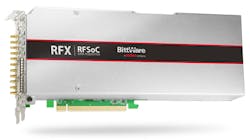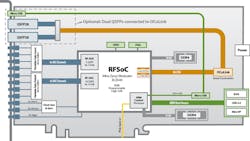What you’ll learn:
- We need new methodologies to manage data collection from distributed IoT sensors.
- RFSoC-based solutions teamed with edge server platforms are up to the task in harsh environs.
- Wideband analog RF sensor processing opens up new application domains.
Edge computing is a buzzword with a vague and evolving definition, particularly when combined with the Internet of Things (IoT). But one thing is clear: It highlights the explosion of data generation, collection, and analysis. We need new methodologies to deal with this explosion, in part because data-center and cloud capabilities are too far removed from the origin of the data. Giving engineers new capabilities to place sensors and sensor processing on the edge will drive new solutions that leverage these emerging technologies.
This is essential because as much as 70% of data generated by sources such as car sensors or video surveillance imagery is predicted to occur at the edge—outside the immediate reach of data centers. Should that raw information be moved over long distances to data centers, or should the data be filtered, pre-processed, and analyzed in real-time right where it’s generated?
Keep in mind that in addition to swamping networks and clouds with data, there are other downsides to moving all sensor information to racks of environmentally controlled servers, including added latency, higher bandwidth requirements, and decreased security. Besides, after all of the trouble associated with moving that data, the servers need to filter out large chunks of data before further processing anyway.
While presenting new computing challenges, it’s obviously advantageous to do more data processing at the data source. That’s where a nimbler approach already has been modeled with video sensors for surveillance. With the millions of CCTV/surveillance cameras in the world—far too many to be continually monitored by humans—sending all raw video data to the cloud for thorough analysis is similarly untenable.
It’s for this reason that edge video systems use filters and data-reduction techniques, such as facial recognition, to reduce the video frame to faces only. Those selected images then can be sent at a much lower bandwidth. Alternatively, the faces themselves could be further processed at the edge with more advanced processor systems to recognize and store things like facial parameters, prior to sending more relevant and lower bandwidth results or alerts.
New Tools for RF Edge Processing
Video is just one useful edge sensor/processing domain. Many others could be deployed to provide valuable information, but just as with the video example, intelligent real-time data reduction must be implemented so that users can filter out the most meaningful and actionable information.
The emergence of new devices called RFSoCs (RF systems-on-chip), which combine high-speed analog-to-digital converters (ADCs) for receiving and digital-to-analog converters (DACs) for transmitting with FPGA fabrics and microprocessor cores in a single chip, now enable that in the RF domain. Rather than using a camera to recognize faces, an antenna “sees” the unexpected transmitters or implements rudimentary radar-like sensors to detect vehicles.
For years, analog RF at the edge has involved analog processing to filter down to narrowband signals to use in communications. Accomplishing this in the digital domain, however, has been limited to expensive and complex applications in areas like military, defense, and aerospace—until now.
BittWare, a Molex Company, designed the RFX-8440 and RFX-8441 cards around the third-generation RFSoCs from Xilinx (Fig. 1). It resulted in a standard off-the-shelf commercial PCIe card that connects to analog sensors and plugs into servers designed for the edge (Fig. 2).
By using RFSoC cards like these at the edge, the advantages of moving data processing near the source can be leveraged in the RF domain. Plus, there’s the additional benefit of leveraging the economics of a standard PCIe-based solution.
Edge Servers to Complete the Package
Hearing “servers” at the edge might make anyone wonder—is this about creating a fully environmentally controlled data center near the antenna? Or is this about referencing specialized rugged hardware for military and defense? Both considerations are too extreme a design choice.
That’s why a new range of edge server platforms are emerging from tier-one vendors like Dell, HPE, and SuperMicro. These server systems are purpose-built for edge environments without the need for customization and the associated costs of traditional rugged systems that meet military specifications. One example of this is the TeraBox 200DE server from BittWare. Based on Dell Technologies’ PowerEdge XE2420 server for harsh computing environments, it includes features like dust filters and extended operating temperatures.
This new breed of servers targeting the edge recognizes that the intended environment isn’t as controlled as a typical data center. Instead, deployment may be on poles or outdoor cabinets, where preventing dust and other contaminants from entering, weathering extended temperatures, and ensuring reliability in more rigorous physical settings becomes essential. Likewise, smart cable management and connector access is necessary for ease of setup and maintenance.
New Possibilities
With card-level solutions using RFSoCs and economical PCIe-based servers, new possibilities emerge for commercial applications. Wideband analog RF sensor processing now can be deployed, much like current camera and video sensors.
Although gathering and setting up the handling of data is one challenge, what to do with these capabilities is quite another. That’s where innovative solutions providers are needed to open the door for engineering creativity. If presented with an RFSoC card deployed in a commercial edge server, what types of applications come to mind?
One response might be spectral analysis to detect emissive devices. A lot of focus has centered on edge detection using video for tasks like facial recognition, but the RF spectrum opens additional possibilities. In RF, items like drones, cell phones, and Bluetooth devices can be “seen,” and they might be easier to detect and identify by their emissions than with video.
Another potential application is scanning for RFIDs. If the application calls for interrogation signals, there’s no problem. The RFSoC can generate these directly to the antenna and then listen for the response. These are a few of the many options—many more possibilities are in the offing. Opportunities and applications abound for designing solutions to take full advantage of having real-time access to RF analog data.
Taking the Next Steps
Edge computing for video surveillance and 5G has grown significantly, in part because of investments and a growing ecosystem of solutions in those markets. There remain many other underserved markets, though, with other types of sensor data that could exploit the benefits and lower economics of edge computing with off-the-shelf solutions. By moving to RFSoC-based PCIe cards and servers, engineers gain more options in their toolbox to innovate and develop better solutions for navigating the opportunities happening at the edge.


